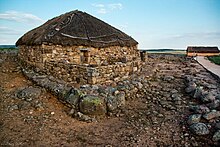Numantia
Numantia ( Spanish : Numancia ) was the capital of the Celtiberians or the Celts in the north of the Iberian Peninsula .
location
The excavation site Numantia is located in the north of today's Spanish province of Soria near Garray on the 1100 m high Muela de Garray elevation above the Duero river, about 12 km northeast of today's city of Soria and about 160 km west of Saragossa .
history
Numantia was a Celtic oppidum in antiquity that had been inhabited since the Bronze Age. During the Iberian Wars (154-133 BC) between Rome and the Celtiberians , led by Viriatus , the city was a heavily fortified center of resistance. The first Roman attack in 153 BC BC failed because the deployed elephants trampled their own camp after they had been pelted with stones by the Celtiberians. In 141 BC The Romans under Quintus Pompeius tried again to take the city without success. Eight years later Numantia was conquered for Rome by the younger Scipio (Aemilianus) , the grandson of the victor of Zama , as a result of the siege of Numantia - he surrounded the city and thus triggered a famine in Numantia. The conquest of the city marked the end of the Spanish wars, in the course of which many Roman soldiers had lost their lives.
Numantia was re-founded by Emperor Augustus (r. 31 BC to 14 AD) and lived on as a not insignificant Roman city even in late antiquity; the city was connected to Calagurris Iulia ( Calahorra ) by a busy road.
literature
- Alfred Heuss : Roman history. 5th edition, licensed edition. Scientific Book Society, Darmstadt 1983, p. 120.
Web links
- Helga Fröhlich: Numantia. (The dispute with the Romans 143-133 BC) die-roemer-online.de, November 29, 2015
Coordinates: 41 ° 48 ′ 34 " N , 2 ° 26 ′ 39" E


